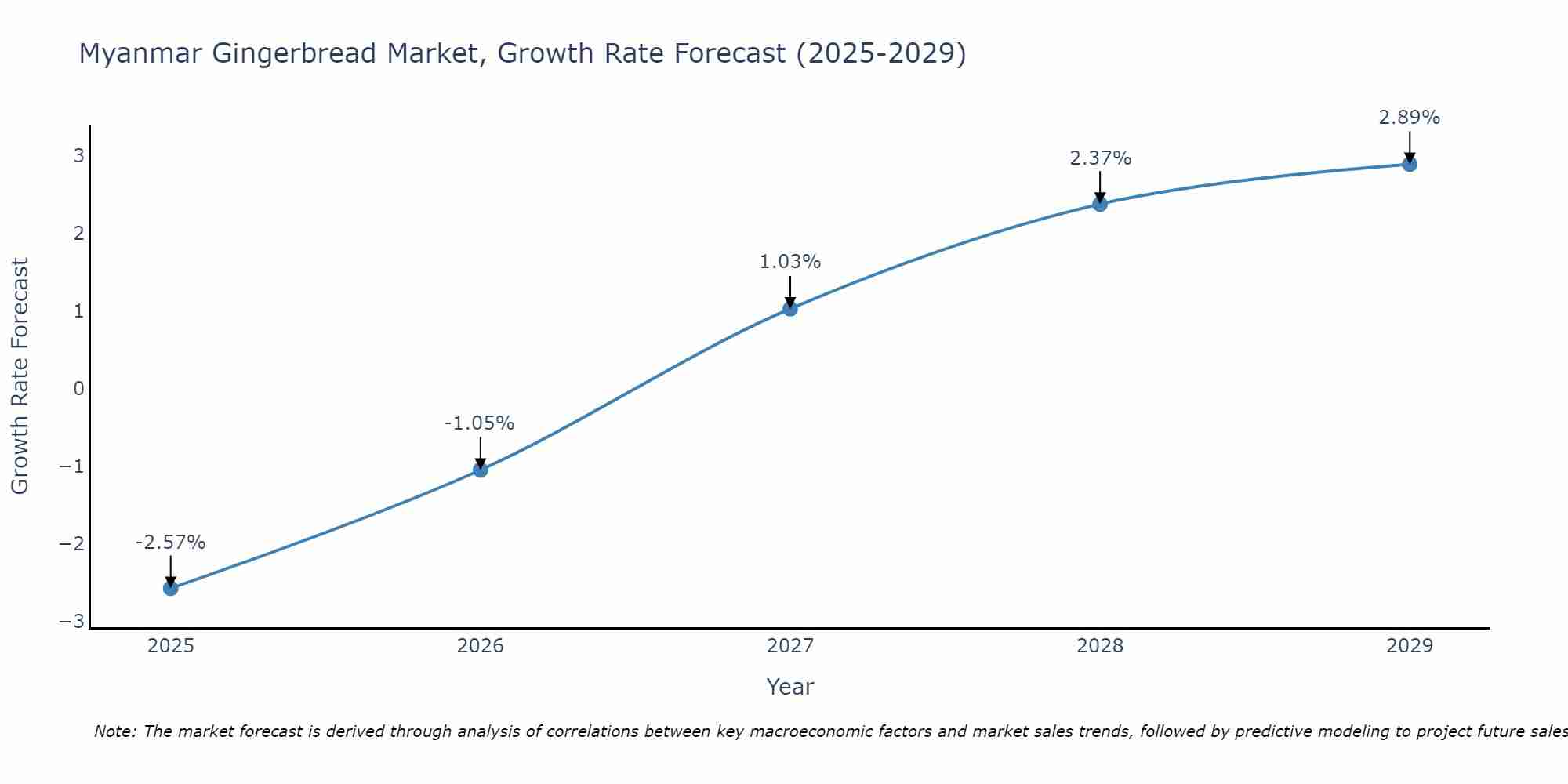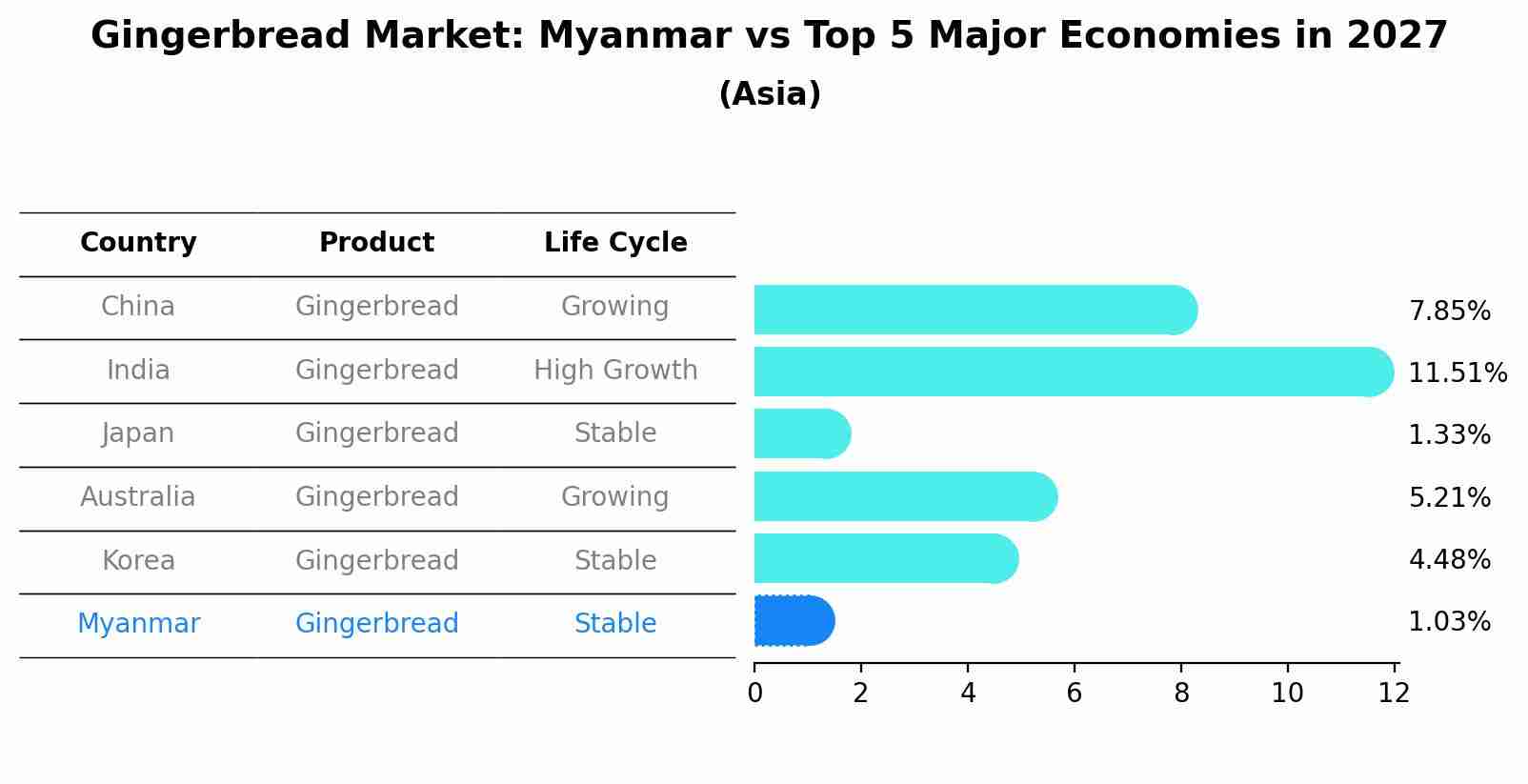Myanmar Gingerbread Market (2025-2031) Outlook | Value, Analysis, Industry, Revenue, Trends, Growth, Companies, Size, Forecast & Share
| Product Code: ETC410850 | Publication Date: Oct 2022 | Updated Date: Jul 2025 | Product Type: Market Research Report | |
| Publisher: 6Wresearch | Author: Dhaval Chaurasia | No. of Pages: 75 | No. of Figures: 35 | No. of Tables: 20 |
Myanmar Gingerbread Market Size Growth Rate
The Myanmar Gingerbread Market is likely to experience consistent growth rate gains over the period 2025 to 2029. From -2.57% in 2025, the growth rate steadily ascends to 2.89% in 2029.

Gingerbread Market: Myanmar vs Top 5 Major Economies in 2027 (Asia)
By 2027, the Gingerbread market in Myanmar is anticipated to reach a growth rate of 1.03%, as part of an increasingly competitive Asia region, where China remains at the forefront, supported by India, Japan, Australia and South Korea, driving innovations and market adoption across sectors.

Myanmar Gingerbread Market Synopsis
The Myanmar Gingerbread market is experiencing steady growth driven by factors such as increasing consumer interest in traditional snacks and the rising popularity of ginger-based products for their perceived health benefits. Gingerbread is a common treat in Myanmar, enjoyed for its unique flavor profile and cultural significance. The market offers a variety of gingerbread products, including cookies, cakes, and biscuits, catering to different consumer preferences. Local bakeries and small-scale producers dominate the market, providing authenticity and traditional recipes that appeal to consumers looking for nostalgic flavors. The market is also witnessing a trend towards innovative gingerbread products, such as gluten-free and organic options, to meet the evolving demands of health-conscious consumers. Overall, the Myanmar Gingerbread market presents opportunities for both traditional and modern producers to capitalize on the growing consumer interest in this beloved snack.
Myanmar Gingerbread Market Trends
The Myanmar gingerbread market is experiencing a growing demand for traditional gingerbread snacks due to their unique flavors and cultural significance. Consumers are increasingly seeking out locally-produced gingerbread treats that are made with high-quality ingredients and authentic recipes. Artisanal gingerbread products are gaining popularity, as they are perceived as healthier alternatives to mass-produced snacks. Additionally, there is a rising interest in gingerbread items that cater to specific dietary preferences, such as gluten-free or vegan options. The market is also seeing innovative flavor combinations and packaging designs to attract younger consumers. Overall, the Myanmar gingerbread market is evolving to meet the changing tastes and preferences of consumers while preserving the rich heritage of this beloved snack.
Myanmar Gingerbread Market Challenges
In the Myanmar Gingerbread market, challenges include fluctuating prices of ginger, which is a key ingredient in gingerbread production. Farmers face uncertainties due to weather conditions impacting ginger yields, leading to price volatility. Additionally, limited access to technology and modern farming practices hinders productivity and quality control in ginger production. Distribution challenges, such as inadequate infrastructure and transportation systems, also pose obstacles in reaching wider markets. Furthermore, competition from imported gingerbread products and changing consumer preferences towards healthier snacks present challenges for local gingerbread producers in Myanmar. Overcoming these obstacles will require investments in agricultural technology, infrastructure improvements, and market diversification strategies to sustain and grow the gingerbread market in Myanmar.
Myanmar Gingerbread Market Investment Opportunities
The Myanmar gingerbread market presents several promising investment opportunities due to the increasing popularity of gingerbread products both locally and internationally. Investors can consider opportunities in gingerbread production facilities, distribution networks, and product innovation to capitalize on the growing demand for this traditional treat. Additionally, investing in marketing and branding strategies to promote Myanmar gingerbread as a high-quality and unique product in the global market could also yield significant returns. With the rising interest in authentic and artisanal food products, the Myanmar gingerbread market offers potential for growth and expansion, making it an attractive investment option for those looking to enter the confectionery industry.
Jordan Agar Market Government Policies
Government policies related to the Myanmar Gingerbread Market focus on promoting local production, ensuring food safety standards, and supporting small-scale producers. The government has implemented measures to encourage gingerbread makers to use locally sourced ingredients, thereby boosting the domestic agricultural sector. Additionally, regulations are in place to uphold quality control and hygiene standards in gingerbread production facilities to safeguard consumer health. The government also provides financial and technical assistance to small-scale gingerbread producers to enhance their production capabilities and competitiveness in the market. Overall, these policies aim to stimulate the growth of the Myanmar gingerbread market while ensuring that products meet regulatory requirements and consumer expectations.
Myanmar Gingerbread Market Future Outlook
The future outlook for the Myanmar Gingerbread Market appears promising due to increasing consumer interest in traditional and authentic food products. With growing awareness about the health benefits of ginger and the popularity of artisanal baked goods, the demand for Myanmar gingerbread is expected to rise. Additionally, the rising trend of incorporating unique flavors and ingredients in baked goods presents opportunities for innovation and product differentiation within the gingerbread market. As consumer preferences shift towards natural, locally sourced ingredients, Myanmar gingerbread, known for its distinct flavor and quality, is well-positioned to capitalize on this trend. Market players can leverage these opportunities by focusing on product development, marketing strategies, and expanding distribution channels to cater to the evolving tastes of consumers and drive growth in the gingerbread market in Myanmar.
Key Highlights of the Report:
- Myanmar Gingerbread Market Outlook
- Market Size of Myanmar Gingerbread Market, 2024
- Forecast of Myanmar Gingerbread Market, 2031
- Historical Data and Forecast of Myanmar Gingerbread Revenues & Volume for the Period 2021 - 2031
- Myanmar Gingerbread Market Trend Evolution
- Myanmar Gingerbread Market Drivers and Challenges
- Myanmar Gingerbread Price Trends
- Myanmar Gingerbread Porter's Five Forces
- Myanmar Gingerbread Industry Life Cycle
- Historical Data and Forecast of Myanmar Gingerbread Market Revenues & Volume By Application for the Period 2021 - 2031
- Historical Data and Forecast of Myanmar Gingerbread Market Revenues & Volume By Household for the Period 2021 - 2031
- Historical Data and Forecast of Myanmar Gingerbread Market Revenues & Volume By Commercial for the Period 2021 - 2031
- Historical Data and Forecast of Myanmar Gingerbread Market Revenues & Volume By Distribution Channel for the Period 2021 - 2031
- Historical Data and Forecast of Myanmar Gingerbread Market Revenues & Volume By Online for the Period 2021 - 2031
- Historical Data and Forecast of Myanmar Gingerbread Market Revenues & Volume By Offline for the Period 2021 - 2031
- Myanmar Gingerbread Import Export Trade Statistics
- Market Opportunity Assessment By Application
- Market Opportunity Assessment By Distribution Channel
- Myanmar Gingerbread Top Companies Market Share
- Myanmar Gingerbread Competitive Benchmarking By Technical and Operational Parameters
- Myanmar Gingerbread Company Profiles
- Myanmar Gingerbread Key Strategic Recommendations
Frequently Asked Questions About the Market Study (FAQs):
- Single User License$ 1,995
- Department License$ 2,400
- Site License$ 3,120
- Global License$ 3,795
Search
Thought Leadership and Analyst Meet
Our Clients
Related Reports
- Canada Oil and Gas Market (2026-2032) | Share, Segmentation, Value, Industry, Trends, Forecast, Analysis, Size & Revenue, Growth, Competitive Landscape, Outlook, Companies
- Germany Breakfast Food Market (2026-2032) | Industry, Share, Growth, Size, Companies, Value, Analysis, Revenue, Trends, Forecast & Outlook
- Australia Briquette Market (2025-2031) | Growth, Size, Revenue, Forecast, Analysis, Trends, Value, Share, Industry & Companies
- Vietnam System Integrator Market (2025-2031) | Size, Companies, Analysis, Industry, Value, Forecast, Growth, Trends, Revenue & Share
- ASEAN and Thailand Brain Health Supplements Market (2025-2031) | Strategy, Consumer Insights, Analysis, Investment Trends, Opportunities, Growth, Size, Share, Industry, Revenue, Segments, Value, Segmentation, Supply, Forecast, Restraints, Outlook, Competition, Drivers, Trends, Demand, Pricing Analysis, Competitive, Strategic Insights, Companies, Challenges
- ASEAN Bearings Market (2025-2031) | Strategy, Consumer Insights, Analysis, Investment Trends, Opportunities, Growth, Size, Share, Industry, Revenue, Segments, Value, Segmentation, Supply, Forecast, Restraints, Outlook, Competition, Drivers, Trends, Demand, Pricing Analysis, Competitive, Strategic Insights, Companies, Challenges
- Europe Flooring Market (2025-2031) | Outlook, Share, Industry, Trends, Forecast, Companies, Revenue, Size, Analysis, Growth & Value
- Saudi Arabia Manlift Market (2025-2031) | Outlook, Size, Growth, Trends, Companies, Industry, Revenue, Value, Share, Forecast & Analysis
- Uganda Excavator, Crane, and Wheel Loaders Market (2025-2031) | Strategy, Consumer Insights, Analysis, Investment Trends, Opportunities, Growth, Size, Share, Industry, Revenue, Segments, Value, Segmentation, Supply, Forecast, Restraints, Outlook, Competition, Drivers, Trends, Demand, Pricing Analysis, Competitive, Strategic Insights, Companies, Challenges
- Rwanda Excavator, Crane, and Wheel Loaders Market (2025-2031) | Strategy, Consumer Insights, Analysis, Investment Trends, Opportunities, Growth, Size, Share, Industry, Revenue, Segments, Value, Segmentation, Supply, Forecast, Restraints, Outlook, Competition, Drivers, Trends, Demand, Pricing Analysis, Competitive, Strategic Insights, Companies, Challenges
Industry Events and Analyst Meet
Whitepaper
- Middle East & Africa Commercial Security Market Click here to view more.
- Middle East & Africa Fire Safety Systems & Equipment Market Click here to view more.
- GCC Drone Market Click here to view more.
- Middle East Lighting Fixture Market Click here to view more.
- GCC Physical & Perimeter Security Market Click here to view more.
6WResearch In News
- Doha a strategic location for EV manufacturing hub: IPA Qatar
- Demand for luxury TVs surging in the GCC, says Samsung
- Empowering Growth: The Thriving Journey of Bangladesh’s Cable Industry
- Demand for luxury TVs surging in the GCC, says Samsung
- Video call with a traditional healer? Once unthinkable, it’s now common in South Africa
- Intelligent Buildings To Smooth GCC’s Path To Net Zero


















